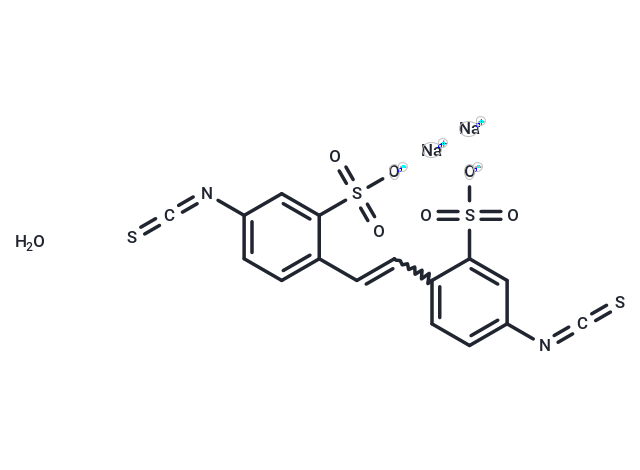Shopping Cart
- Remove All
 Your shopping cart is currently empty
Your shopping cart is currently empty

DIDS sodium salt (MDL101114ZA) is a dual inhibitor of the proteins ABCA1 and VDAC1.

| Pack Size | Price | Availability | Quantity |
|---|---|---|---|
| 10 mg | $33 | In Stock | |
| 25 mg | $51 | In Stock | |
| 1 mL x 10 mM (in DMSO) | $30 | In Stock |
| Description | DIDS sodium salt (MDL101114ZA) is a dual inhibitor of the proteins ABCA1 and VDAC1. |
| In vitro | DIDS (<400 μM) has no evident cytotoxic effect on cell viability Pre-treatment with DIDS at the concentration of 100 and 200 μM result in a prevented effect on ALA-SDT-induced cell death, while dose at 50 μM has no inhibition effect. Pre-treatment with DIDS (100 μM) clearly inhibit caspase-3 and caspase-9 activation [2]. |
| Alias | MDL101114ZA |
| Molecular Weight | 498.5 |
| Formula | C16H8N2Na2O6S4 |
| Cas No. | 67483-13-0 |
| Smiles | O.[Na+].[Na+].[O-]S(=O)(=O)c1cc(ccc1C=Cc1ccc(cc1S([O-])(=O)=O)N=C=S)N=C=S |
| Relative Density. | 1.54g/cm3 |
| Storage | keep away from direct sunlight | Powder: -20°C for 3 years | In solvent: -80°C for 1 year | Shipping with blue ice. | ||||||||||||||||||||||||||||||
| Solubility Information | DMSO: 45 mg/mL (90.27 mM), Sonication is recommended. | ||||||||||||||||||||||||||||||
Solution Preparation Table | |||||||||||||||||||||||||||||||
DMSO
| |||||||||||||||||||||||||||||||

Copyright © 2015-2025 TargetMol Chemicals Inc. All Rights Reserved.